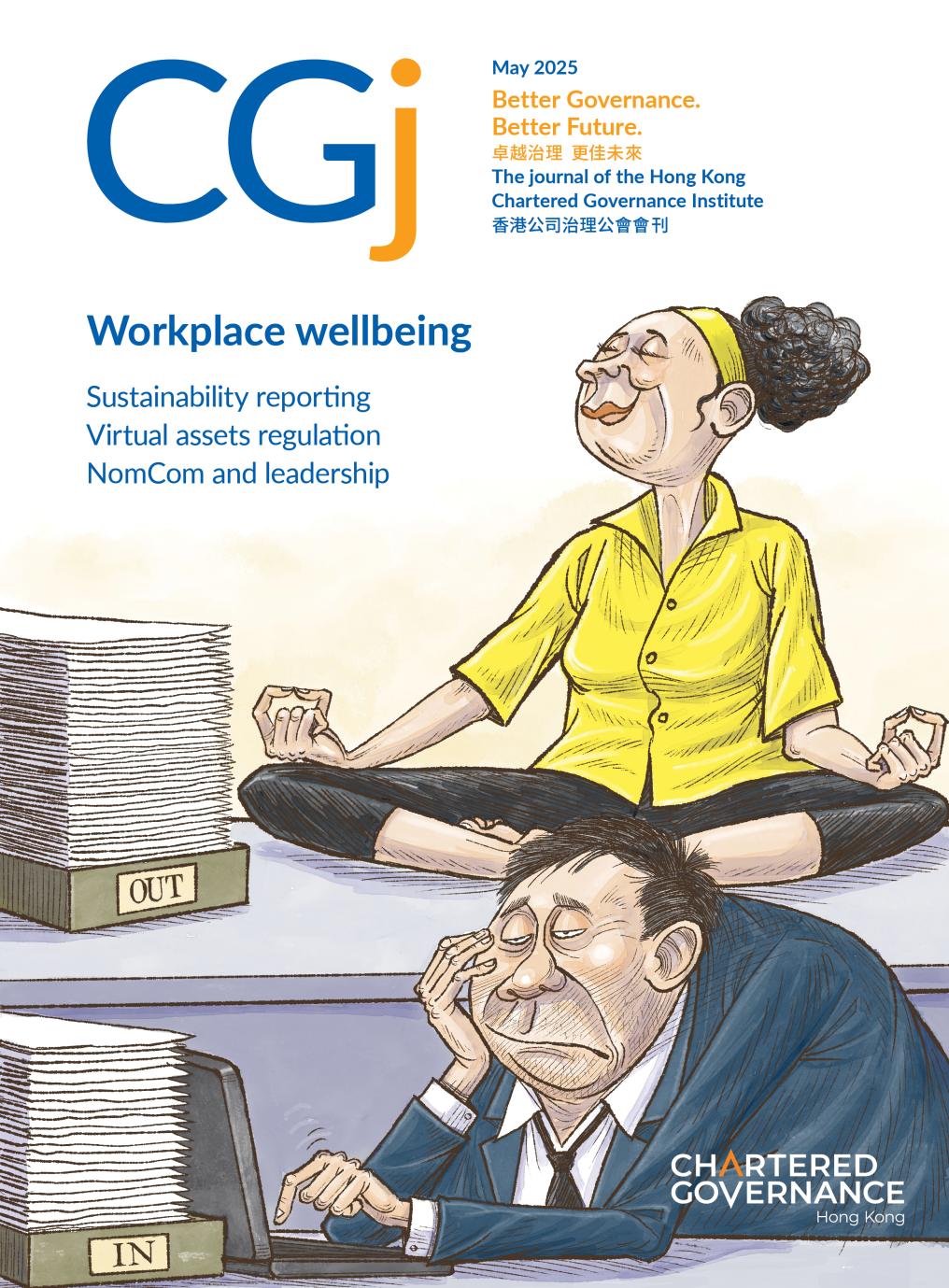
Mental wellbeing and health in the workplace
Dr Austin Tay, Organisational Psychologist and Founder of Omnipsi Consulting, explores the critical importance of mental wellbeing in the workplace and discusses future trends that will shape sustainable mental health strategies.
Highlights
- organisations that prioritise mental health initiatives see significant returns, including reduced absenteeism, better employee engagement and improved organisational performance
- sustainable workplace wellbeing requires leadership commitment and clear communication, as well as the integration of mental health initiatives into policies and practices
- future trends emphasise digital mental health solutions, personalised support and robust hybrid work systems to address evolving workplace dynamics
In today’s rapidly evolving work environment, mental wellbeing and health have emerged as critical concerns for organisations and employees. The Covid-19 pandemic significantly impacted workplace mental health, with longitudinal studies showing substantial increases in anxiety, depression and stress among workers globally. Research indicates a doubling of severe mental health disorders during the pandemic period, with particularly severe impacts on frontline workers and those adapting to remote work environments.
Detailed analysis reveals that different worker groups experienced varying levels of impact. Longitudinal research shows that 45% of remote workers reported decreased mental wellbeing and increased loneliness during enforced work-from-home periods. Young professionals, parents with young children and frontline workers showed particularly high rates of anxiety and depression symptoms, with rates 50% higher than pre-pandemic levels. The pandemic also exposed and exacerbated existing workplace mental health challenges, bringing these issues to the forefront of organisational priorities.
The human cost of poor workplace mental health
Poor workplace mental health carries substantial human and economic costs. Recent systematic reviews have shown that workplace stressors can increase mortality rates and healthcare costs. More alarmingly, employees facing mental health challenges often endure a lower quality of life, strained interpersonal relationships and decreased career satisfaction.
The transition to hybrid working patterns introduced new challenges, including – as mentioned above – the fact that as many as 45% of remote workers experience a decline in mental wellbeing, as well as heightened loneliness. This underscores the need for organisations to promote mental health in various working environments.
A number of comprehensive systematic reviews indicate that workplace stressors contribute directly to increased mortality and healthcare costs. Research shows these stressors account for approximately US$180 billion in healthcare spending annually and contribute to 120,000 excess deaths each year.
Creating a sustainable culture of wellbeing
“sustainable mental health support requires creating a culture where wellbeing is valued and prioritised”
Recent systematic reviews emphasise that sustainable mental health support requires creating a culture where wellbeing is valued and prioritised. This involves consistent effort and commitment at all organisational levels.
Key elements of such a culture include leadership commitment and role modelling, clear communication about available resources and regular evaluation of programme effectiveness. Wellbeing must also be integrated into workplace policies, with recognition of diverse needs, as well as a focus on continuous adaptation and improvement. Additionally, investment in preventive measures and long-term strategic planning is essential to ensure a lasting impact.
The business case for mental wellbeing
Organisations that prioritise employee mental wellbeing see significant measurable returns. A comprehensive systematic review in 2020 by de Oliveira et al found that workplace mental health interventions generate a positive return on investment (ROI) through multiple channels, as set out below.
Financial returns
- Reduced absenteeism. Studies show a 25% to 30% reduction in sick days, translating to average savings of US$1,600 per employee annually.
- Decreased presenteeism. A 50% improvement in workplace productivity, with estimated gains of US$3,000 to US$4,000 per employee yearly.
- Lower turnover. Up to 40% reduction in staff turnover costs, saving an average of US$5,000 per retained employee.
- Healthcare savings. A 30% reduction in mental health–related claims, representing appreciable insurance premium savings.
Implementation success factors
Early intervention programmes have been shown to deliver the highest ROI, with benefit-to-cost ratios reaching as high as 5:1. Comprehensive programmes that address both prevention and support tend to outperform single-focus initiatives, providing more holistic and effective outcomes. Manager training shows particularly strong returns, with research by Milligan-Saville et al reporting an ROI of £9.98 for every £1 invested through reduced employee sick leave. Additionally, employee assistance programmes have demonstrated consistent returns, with systematic reviews revealing benefit-to-cost ratios ranging from 3:1 to 5:1.
Six evidence-based steps to support employee mental wellbeing
1.Establish comprehensive mental health support systems
A systematic review of workplace counselling programmes showed marked reductions in absenteeism and improved job satisfaction. Organisations implementing comprehensive support systems reported a 30% reduction in stressrelated absence, a 40% improvement in employee engagement and a 25% reduction in turnover intention, as well as notable improvements in team performance metrics.
- Structural components. These components include professional counselling services with both in-person and virtual options, employee assistance programmes with 24/7 access, regular mental health workshops and training sessions, crisis support systems with clear escalation protocols and confidential reporting mechanisms.
- Implementation steps. These steps involve conducting needs assessments across different employee groups, developing clear access protocols and communication channels, ensuring confidentiality and privacy protection, creating multiple access points for support services, and establishing monitoring and evaluation systems.
2.Develop manager mental health training
Studies demonstrate that manager training in mental health support significantly reduces employee sick leave. A randomised controlled trial showed that mental health training for managers provides substantial returns through reduced absenteeism.
- Core training components. These entail a recognition of mental health challenges and early warning signs, supportive conversation skills and active listening techniques, resource awareness and appropriate referral pathways, workload management and stress reduction strategies, crisis intervention and escalation procedures, legal obligations and duty of care responsibilities, and creating psychologically safe team environments.
- Implementation framework. This calls for initial comprehensive training sessions for all managers, regular refresher courses and skills updates, practical scenariobased learning exercises, peer support networks for managers, access to expert consultation when needed, assessment of training effectiveness and integration with performance management systems.
- Outcomes. Research demonstrates a number of measurable outcomes of manager mental health training, including a reduction in work-related sick leave, improved team communication and morale, earlier identification of mental health issues, better utilisation of support services, enhanced team performance metrics, increased employee trust in leadership and reduced stigma around mental health discussions.
3. Create flexible working arrangements
Research indicates that flexible working arrangements contribute noticeably to employee wellbeing. Studies demonstrate that wellimplemented flexible arrangements can lead to a 25% reduction in work-related stress, improved job satisfaction scores, better work–life balance reports, increased productivity, higher employee retention rates, enhanced employee engagement and reduced commuting-related stress.
- Core flexibility components. These components involve remote work options with clear guidelines, flexible start and finish times, compressed work weeks where feasible, job sharing opportunities, part-time work options, core hours with flexible scheduling and meeting-free time blocks for focused work.
- Implementation framework. These steps include clear policy development with employee input, technology infrastructure to support remote work, training for managers on managing flexible teams, regular review and adjustment of arrangements, performance measurement based on outcomes, clear communication protocols and equal access to flexibility options.
- Success factors. Success factors encompass leadership modelling of flexible work practices, a trustbased management approach, regular feedback collection and response, technology support and training, clear boundaries between work and personal time, fair and transparent implementation, and regular policy reviews and updates.
4. Foster positive social connections
Studies show that positive workplace relationships significantly enhance psychological health. Building strong social connections at work creates resilience and cultivates robust support networks.
- Structured approaches. These approaches comprise regular team-building activities, cross-functional project teams, mentoring programmes, employee resource groups, social networking platforms, shared learning opportunities and community service initiatives.
- Implementation steps. These steps require assessing the current social connection opportunities, designing inclusive social activities, creating multiple channels for interaction, establishing mentoring frameworks, supporting employee-led interest groups, scheduling regular team activities, and monitoring participation and engagement.
- Success indicators. Such indicators consist of increased collaboration across teams, improved knowledge sharing, enhanced psychological safety, stronger team cohesion, better conflict resolution, reduced isolation reports and higher engagement scores.
5. Implement regular wellbeing check-ins
Systematic reviews demonstrate that regular wellbeing monitoring and support undeniably improve mental health outcomes. Research indicates that regular check-ins lead to earlier identification of mental health concerns. Additionally, measurable outcomes include improved employee–manager relationships, higher levels of employee trust, better resource utilisation, reduced turnover intentions, increased engagement scores and more effective performance management.
- Core components. These entail one-to-one manager–employee meetings, structured wellbeing conversations, team pulse surveys, anonymous feedback mechanisms, regular performance dialogues, mental health check-ins and career development discussions.
- Implementation framework. This framework involves establishing regular check-in schedules, training managers in effective check-in techniques, creating standardised discussion guides, developing follow-up protocols, setting up confidential reporting systems, monitoring trends and patterns, and providing response mechanisms for identified issues.
- Success factors. Success factors include consistency in implementation, quality of conversations, clear action pathways, the maintenance of confidentiality, adequate response resources, regular review and adjustment, and leadership commitment.
6. Prioritise work–life balance
Research shows that organisations that implement clear work–life boundaries see improved mental health outcomes. Studies demonstrate benefits such as reduced burnout rates, lower stress levels, improved job satisfaction, better physical health outcomes, enhanced productivity, increased creativity and stronger team performance.
- Key strategies. Strategies cover clear working-hour policies, email and communication guidelines, vacation encouragement policies, workload monitoring systems, meeting management protocols, digital disconnection rights and family friendly policies.
- Implementation steps. Steps incorporate developing clear work–life balance policies, training managers in workload management, establishing monitoring mechanisms, creating support systems for peak periods, regular workload reviews, vacation planning support and family leave management.
- Best practices. Best practices comprise leading by example at all levels, regular policy communication, consistent implementation, cultural sensitivity, regular policy reviews, employee feedback integration and a continuous improvement approach.
The role of employees
While support from the organisation is crucial, research indicates that employee involvement in mental health initiatives is equally important. Successful workplace mental health programmes also require the active engagement of employees at all levels.
Key actions that employees can take include proactively using the provided mental health resources, actively participating in wellbeing check-ins and engaging in honest communication with managers about challenges. Employees should also focus on developing personal stress management strategies, building supportive professional networks and setting clear personal boundaries. By contributing to a positive team culture and taking the initiative to focus on mental wellbeing, employees can effectively support not just their own mental health, but also that of their colleagues.
Looking ahead
The future of workplace mental wellbeing necessitates a collaborative approach between organisations and employees. As workplace dynamics continues to evolve, mental wellbeing is set to become an even more urgent issue for organisations.
Key future trends include the integration of digital mental health solutions and an increased emphasis on preventive measures. There will also be a greater focus on work–life integration and the evolution of hybrid work support systems to address the unique challenges of remote and flexible work environments. Enhanced measurement and monitoring capabilities are expected to improve the evaluation of mental health initiatives, while the development of personalised support approaches will cater to individual employee needs. Additionally, the growing importance of mental health literacy and the expansion of peer support programmes will play a vital role in fostering a supportive workplace culture.
Organisations that prioritise mental health support today will be better equipped to sustain a resilient, engaged and productive workforce in the future. By embracing these trends and adapting to the changing needs of their employees, businesses can ensure long-term success while promoting a culture of wellbeing.
Dr Austin Tay
Organisational Psychologist and Founder of Omnipsi Consulting
The author can be contacted via the Omnipsi Consulting website: www.omnipsi.com.


